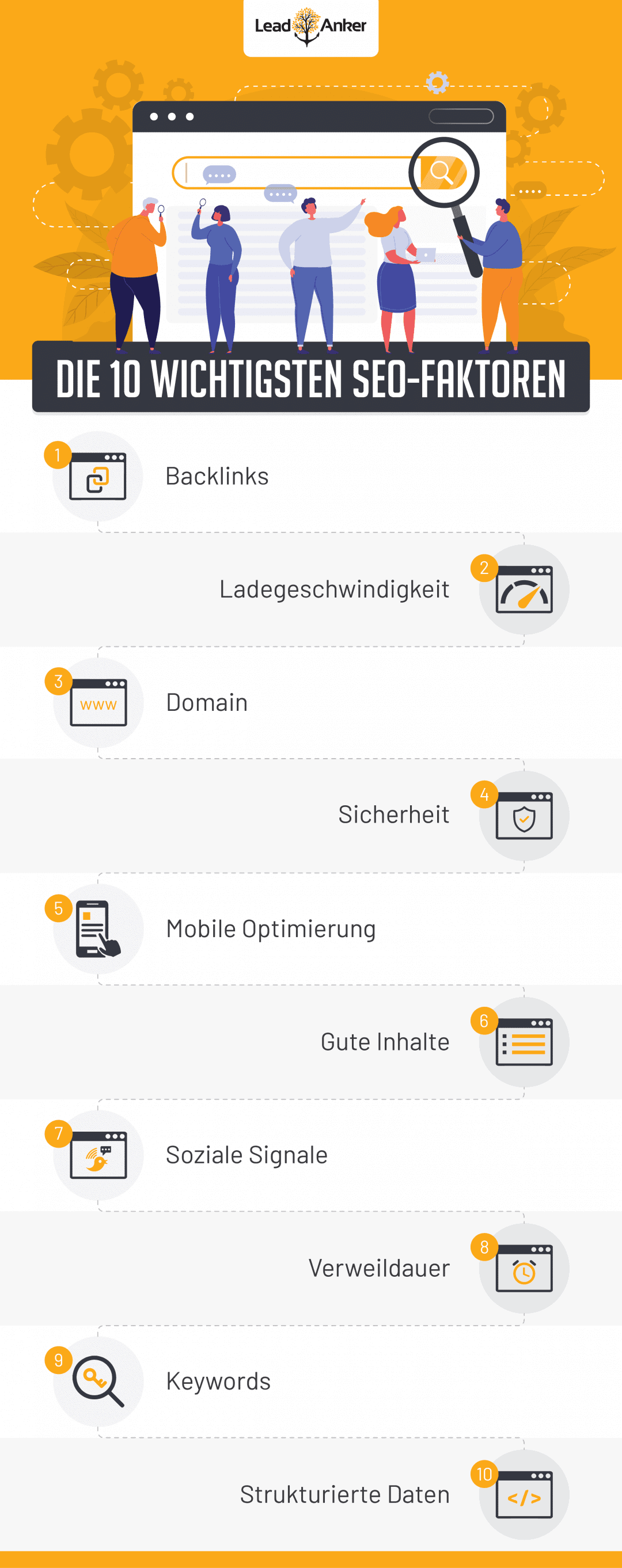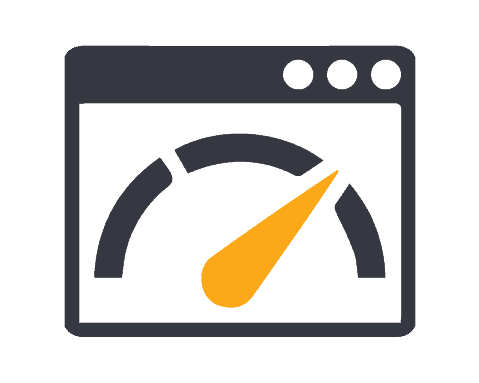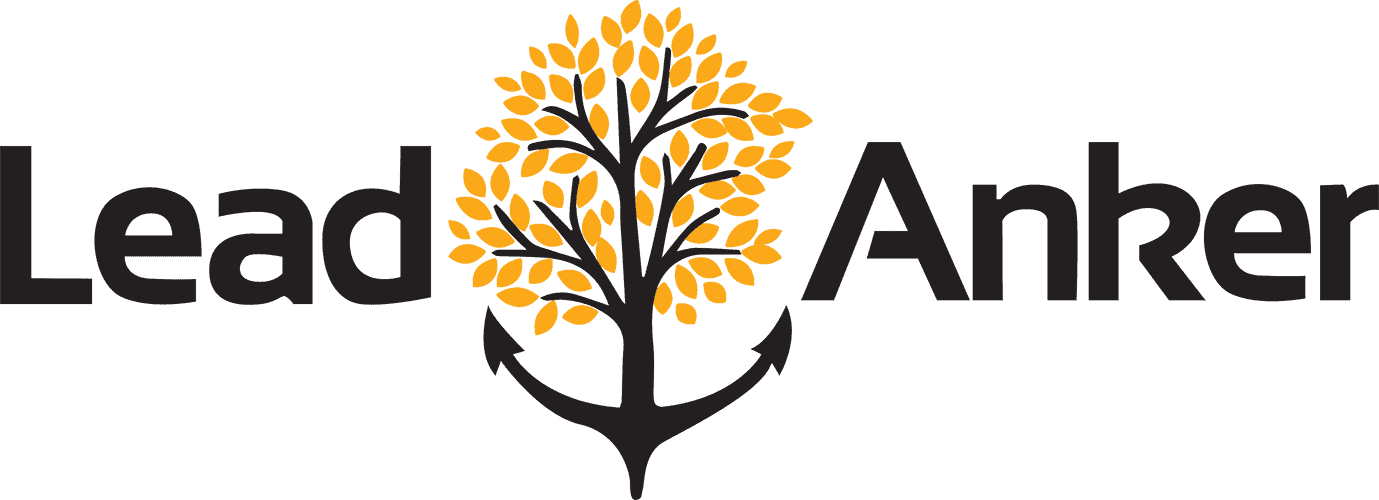The topic of SEO (Search Engine Optimization) is now familiar to almost everyone involved with websites. SEO describes strategies and tactics to increase the visibility of a website on search engines like Google.
The higher a web page is ranked for relevant search queries in a search engine, the more often it is clicked. Websites that are optimized for search engines therefore receive significantly more visitors (and resulting customers and inquiries).
Today we present what we consider to be the 10 most important ranking factors for SEO and provide useful tips on how to implement them.
For those who are in a hurry: The following infographic provides a brief overview - the details will be discussed thereafter.
Do you need an individual but non-binding consultation?
We would be happy to look at the potential and possible weaknesses of your website together. Just contact us for a free consultation, during which we will examine your website with the help of software and show you new ways.


Even nowadays, backlinks are extremely important - even if you don't hear as much about the subject as you did a few years ago.
What are backlinks? Here is a simplified explanation:
Backlinks are links from other websites that point to your own website. This is a signal to the search engine that a website is important. If the website on which the link was placed has many backlinks itself, the effect is even stronger.
Therefore, for a good ranking in search engines, it is important to collect as many backlinks as possible from high-quality websites.
In the meantime, many companies have focused more on content marketing and have lost sight of the issue of backlinks. Search engines still weight backlinks very heavily as a ranking factor.
The own backlink profile should always be kept in mind and optimized. Free tools from ahrefs or neilpatel provide an initial overview of how your own backlink profile is doing.
How to strengthen your own backlink profile by creative methods we will present soon in another post.
What you can do now:


No user wants to wait forever for a website to load. Search engines have also recognized this and index faster websites further ahead. In addition, visitors bounce if a website takes too long to load. Optimizing the loading speed of your website not only sends a strong signal to search engines, but also to website visitors.
How it stands around the own web page speed can for example with this Tool from Google be recognized
Just enter the URL and take a close look at scores and messages.
The most common mistakes we see with slow websites are: Slow hosting, no optimized content and technical factors like CSS/JS.
To increase the loading speed we recommend hosting the website on fast servers and compressing images to the large size recommended by Google.
What you can do now:
A Ahref's study from 2017 shows that almost 60% of the websites in the first 10 places on Google are 3 years old or older. If a domain (=web address) has already existed for some time, search engines perceive this as more trustworthy.
There is very little you can do about this factor yourself. However, if you plan to operate a website in the future, you can already reserve the domain. Nevertheless, other factors can be influenced at the domain level.
Domain Authority (DA) is a widely used metric for determining the importance of your website. Domain authority is composed of several factors, all of which are optimized in the best case.
Another factor on the domain level are the URLs of the individual subpages. Here it is important that the URL contains the keyword (=search term, see also factor 9). A positive example of a URL for the optimization of the keyword "image film" would be, for example: www.lead-anker.de/imagefilm. A negative example of this would be: www.lead-anker.de/aycf35drRjyCMu1dmqVN.
What you can do now:


A website equipped with SSL (= secure sockets layer) allows an encrypted connection between the website visitor and the server. Normally, data is transferred between servers and clients without encryption.
This poses risks when transmitting sensitive data (e.g. personal data or means of payment). SSL is an encryption protocol and therefore an important safety signal to Google. Since the DSGVO came into force, there is an SSL obligation for websites with certain data transmission, e.g. when using a contact form. Some internet browsers now block websites that do not have a valid SSL certificate.
Those who protect the visitors of their website with SSL are not only DSGVO compliant and optimize their visibility in search engines, but also take care of the security of their visitors.
Whether a website uses SSL or not can be easily seen by the green lock that appears in the browser window next to the URL entered.
What you can do now:
In the meantime, approximately 50% websites are visited by mobile devices such as smartphones and tables - and the trend is rising. Google has therefore taken measures and created the "mobile-first index". Since 2016, websites are indexed first via the mobile version.
Those who still do not make their website available for visitors from mobile devices will have to put up with high abpsrung rates and low visibility in search engines.
An elegant solution for a mobile-friendly website is responsive design. Here, the website always adapts to the screen size. To check this, you can simply reduce the browser window and see if the content adapts. It is important that larger content such as headlines automatically adapt to mobile devices and shrink. Also, the mobile navigation (menus, buttons) should be kept simple and user-friendly.
What you can do now:


There is less long, good content than short, good content. It's not easy to consistently publish high-quality content. However, this approach is worth its weight in gold for your own visibility in search engines.
Content that presents a topic in detail and in an understandable way offers website visitors great added value, as it provides more information than other sources.
Search engines also benefit from longer content - they can better understand and rank the topics discussed with more text. There is a correlation between the length of a website's content and its position on Google.
The goal should never be to write as much as possible. Only if the quality of the content is right, a long text is appropriate. Search engines notice when the content of a page is long, but the dwell time of visitors is short.
What you can do now:
One of the main functions of social networks like Facebook, Instagram or Twitter is to share content. If links to your website are shared, you will get more website visitors and visibility. To do this, the social media accounts themselves can show up in search results.
It is true that social signals are not yet a direct ranking factor for Google. However, these signals influence a number of other important SEO factors that search engines measure.
In addition to positive effects such as reach, community building and interaction, building your social media presence can therefore also help you get listed higher in search engines.
What you can do now:


Dwell time describes how long a visitor spends on your individual web pages. One way that search engines such as Google measure this time is by observing search behavior. If a user enters a search phrase in a search engine, then clicks on the first result and jumps back to the search page after a few seconds, the search engine notices this and evaluates it as a negative signal. The content of the page probably did not match the information searched for.
However, if a user searches for a term, clicks on the link and does not return to the search engine, this can be considered a good signal - the user has found his information on the corresponding page. For this reason, it is worthwhile to keep your own visitors on the page as long as possible. Numerous studies have also found a correlation between dwell time and sales at web stores.
What you can do now:
Anyone who deals with SEO has probably heard of you: the famous keywords. These are search terms that are entered into search engines.
One thing is important for you and your website - you want to show up as high as possible for the right keywords. Why does the graphic actually look like a fried egg in a pan? Hopefully this post doesn't rank with the recipes now... Well, back to the topic: The right keywords are still one of the top 10 ranking factors for search engines.
There are three types of keywords: short tail, medium tail and long tail. Short tail keywords are non-specific and broad, long tail keywords are very topic-specific and narrow, medium tail a mixture of the two. Which type of keywords you should optimize for depends mostly on the competition in SEO in your industry. If the competition is high, it will be difficult to rank for short tail keywords.
A good approach always includes research for suitable keywords, competitive analysis, and incorporating the most effective keywords into your own website.
What you can do now:


Structured data generally refers to the organization of information. Instead of presenting information in a jumble, it is tidied up and presented neatly with the help of a structure.
In the context of SEO, the application of structured data is the inclusion of a markup on a page. Thus, additional information about the website is displayed in search engines.
The most widely used markup is from schema.org. The result are so called rich search results. These include e.g. styling, images or visual enhancements - and this directly in the search results. This naturally makes an entry in the search results catch the eye of the searcher much more and the probability that he will click is much higher.
What you can do now:
For us, these factors will be among the most important in SEO in 2024:
We hope you have enjoyed and found this article useful.
